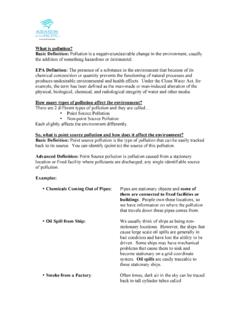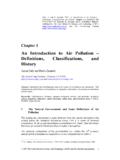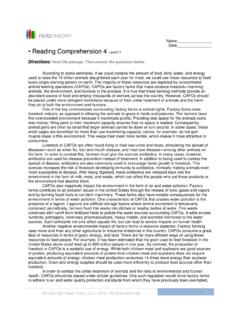Transcription of Benzene - United States Environmental Protection …
1 Benzene71-43-2 Hazard SummaryBenzene is found in the air from emissions from burning coal and oil, gasoline service stations, and motorvehicle exhaust. Acute (short-term) inhalation exposure of humans to Benzene may cause drowsiness,dizziness, headaches, as well as eye, skin, and respiratory tract irritation, and, at high levels,unconsciousness. Chronic (long-term) inhalation exposure has caused various disorders in the blood,including reduced numbers of red blood cells and aplastic anemia, in occupational settings. Reproductiveeffects have been reported for women exposed by inhalation to high levels, and adverse effects on thedeveloping fetus have been observed in animal tests.
2 Increased incidence of leukemia (cancer of the tissuesthat form white blood cells) have been observed in humans occupationally exposed to Benzene . EPA hasclassified Benzene as known human carcinogen for all routes of Note: The main sources of information for this fact sheet are the Agency for Toxic Substances and Disease Registry's (ATSDR's) Toxicological Profile for Benzene (1) and EPA's Integrated Risk Information System (IRIS) (4), which contains information on the health effects of Benzene including the unit cancer risk for inhalation exposure. UsesBenzene is used as a constituent in motor fuels; as a solvent for fats, waxes, resins, oils, inks, paints,plastics, and rubber; in the extraction of oils from seeds and nuts; and in photogravure printing.
3 It is alsoused as a chemical intermediate. Benzene is also used in the manufacture of detergents, explosives,pharmaceuticals, and dyestuffs. (1,2,6)Sources and Potential ExposureIndividuals employed in industries that manufacture or use Benzene may be exposed to the highest levelsof Benzene . (1) Benzene is found in emissions from burning coal and oil, motor vehicle exhaust, and evaporation fromgasoline service stations and in industrial solvents. These sources contribute to elevated levels of benzenein the ambient air, which may subsequently be breathed by the public. (1)Tobacco smoke contains Benzene and accounts for nearly half the national exposure to Benzene . (1)Individuals may also be exposed to Benzene by consuming contaminated water.
4 (1)Assessing Personal ExposureMeasurement of Benzene in an individual's breath or blood or the measurement of breakdown products inthe urine (phenol) can estimate personal exposure. However, the tests must be done shortly after exposureand are not helpful for measuring low levels of Benzene . (1)Health Hazard InformationAcute Effects:Coexposure to Benzene with ethanol ( , alcoholic beverages) can increase Benzene toxicity in humans.(1)Neurological symptoms of inhalation exposure to Benzene include drowsiness, dizziness, headaches, andNeurological symptoms of inhalation exposure to Benzene include drowsiness, dizziness, headaches, and unconsciousness in humans. Ingestion of large amounts of Benzene may result in vomiting, dizziness, and convulsions in humans.
5 (1)Exposure to liquid and vapor may irritate the skin, eyes, and upper respiratory tract in humans. Redness and blisters may result from dermal exposure to Benzene . (1,2)Animal studies show neurologic, immunologic, and hematologic effects from inhalation and oral exposure to Benzene . (1)Tests involving acute exposure of rats, mice, rabbits, and guinea pigs have demonstrated Benzene to have low acute toxicity from inhalation, moderate acute toxicity from ingestion, and low or moderate acute toxicity from dermal exposure. (3)The reference concentration for Benzene is mg/m3 based on hematological effects in humans. The RfC is an estimate (with uncertainty spanning perhaps an order of magnitude) of a continuous inhalation exposure to the human population (including sensitive groups) that is likely to be without appreciable risk deleterious noncancer effects over a lifetime.
6 (4)Chronic Effects (Noncancer):Chronic inhalation of certain levels of Benzene causes disorders in the blood in humans. Benzene specifically affects bone marrow (the tissues that produce blood cells). Aplastic anemia (a risk factor for acute nonlymphocytic leukemia), excessive bleeding, and damage to the immune system (by changes in blood levels of antibodies and loss of white blood cells) may develop. (1)In animals, chronic inhalation and oral exposure to Benzene produces the same effects as seen in humans.(1) Benzene causes both structural and numerical chromosomal aberrations in humans. (1)EPA has established an oral Reference Dose (RfD) for Benzene of milligrams per kilogram per day(mg/kg/d) based on hematological effects in humans.
7 The RfD is an estimate (with uncertainty spanning perhaps an order of magnitude) of a daily oral exposure to the human population (including sensitive subgroups) that is likely to be without appreciable risk of deleterious noncancer effects during a lifetime. It is not a direct estimator of risk, but rather a reference point to gauge the potential for effects. At exposures increasingly greater than the RfD, the potential for adverse health effects increases. Lifetime exposure above the RfD does not imply that an adverse health effect would necessarily occur. (4)EPA has established a Reference Concentration (RfC) of milligrams per cubic meter ( mg/m3) for Benzene based on hematological effects in humans.
8 The RfC is an inhalation exposure concentration at or below which adverse health effects are not likely to occur. It is not a direct estimator of risk, but rather a reference point to gauge the potential for effects. At lifetime exposures increasingly greater than the reference exposure level, the potential for adverse health effects increases. (4)Reproductive/Developmental Effects:There is some evidence from human epidemiological studies of reproductive and developmental toxicity ofbenzene, however the data do not provide conclusive evidence of a link between exposure and effect. (4)Animal studies have provided limited evidence that exposure to Benzene may affect reproductive organs,however these effects were only observed at exposure levels over the maximum tolerated dose.
9 (4)Adverse effects on the fetus, including low birth weight, delayed bone formation, and bone marrowdamage, have been observed where pregnant animals were exposed to Benzene by inhalation.(4)Cancer Risk:Increased incidence of leukemia (cancer of the tissues that form white blood cells) has been observed inhumans occupationally exposed to Benzene . (1,4)EPA has classified Benzene as a Group A, known human carcinogen. (4)EPA uses mathematical models, based on human and animal studies,to estimate the probability of a persondeveloping cancer from breathing air containing a specified concentration of a chemical. EPA calculated arange of x 10-6 to x 10-6 as the increase in the lifetime risk of an individual who is continuouslyexposed to 1 g/m3 of Benzene in the air over their estimates that, if an individual were to continuously breathe the air containing Benzene at an averageof to g/m3 ( to ) over his or her entire lifetime, that person wouldtheoretically have no more than a one-in-a-million increased chance of developing cancer as a direct resultof continuously breathing air containing this chemical.
10 Similarly, EPA estimates that continuously breathingair containing to g/m3( to mg/m3) would result in not greater than a one-in-a-hundred thousand increased chance of developing cancer, and air containing 13 to 45 g/m3 ( x 10-2 to x 10-2 mg/m3) would result in not greater than a one-in-ten thousand increased chance ofdeveloping cancer. For a detailed discussion of confidence in the potency estimates, please see IRIS.(4)EPA has calculated an oral cancer slope factor ranging from x 10-2 to x 10-2(mg/kg/d)-1 that is anextrapolation from inhalation dose-response data. (4)Physical PropertiesThe chemical formula for Benzene is C6H6, and it has a molecular weight of g/mol.
















